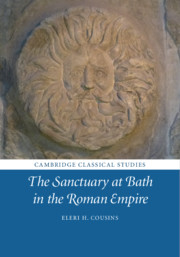Book contents
- The Sanctuary at Bath in the Roman Empire
- Cambridge Classical Studies
- The Sanctuary at Bath in the Roman Empire
- Copyright page
- Contents
- Figures
- Acknowledgements
- Abbreviations
- 1 Discovering Roman Bath
- 2 From Bath to Aquae Sulis
- 3 Experiencing Aquae Sulis
- 4 Aquae Sulis and Empire
- 5 Water from the Earth
- 6 The Local Writ Large
- Conclusion: From Aquae Sulis to Bath
- Bibliography
- Index
6 - The Local Writ Large
Published online by Cambridge University Press: 07 January 2020
- The Sanctuary at Bath in the Roman Empire
- Cambridge Classical Studies
- The Sanctuary at Bath in the Roman Empire
- Copyright page
- Contents
- Figures
- Acknowledgements
- Abbreviations
- 1 Discovering Roman Bath
- 2 From Bath to Aquae Sulis
- 3 Experiencing Aquae Sulis
- 4 Aquae Sulis and Empire
- 5 Water from the Earth
- 6 The Local Writ Large
- Conclusion: From Aquae Sulis to Bath
- Bibliography
- Index
Summary
Building on the themes of regionality in Chapter 4, and of empire in Chapter 3, this chapter focuses on Aquae Sulis’s place in the social, religious, and artistic networks of Britain, Gaul, and Germany specifically, and on how to put the site’s locally specific practices in dialogue with broader trends. It explores the significance of artistic connections seen in smaller iconographic works such as the ‘altar’ blocks, which can be linked to Viergöttersteine from the Rhineland, and the relief of Mercury with a local goddess, which is part of a regional cluster centred on Gloucester, and uses a series of case studies, in particular the ‘curse tablets’, to delineate the ways in which provincial religious knowledge may be characterized as a series of increasingly localized concentric circles of practice.
- Type
- Chapter
- Information
- The Sanctuary at Bath in the Roman Empire , pp. 150 - 186Publisher: Cambridge University PressPrint publication year: 2020

